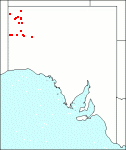Family: Lamiaceae
Prostanthera wilkieana
Citation:
F. Muell., Fragm. Phyt. Aust. 8:230 (1874).
Synonymy: Not Applicable Common name: None
Description:
Erect densely branched shrub, 0.3-1.2 m high; branches densely hairy, appearing silvery, silver-green or grey-green; hairs curled to almost straight, subappressed, especially the shorter hairs, to almost patent, antrorse to retrorse (indumentum appearing scruffy), 0.2-2.1 mm long, with short and long hairs usually present on the same branch, glands absent; leaves silvery, silver-green or grey-green, densely hairy, rarely moderately hairy, glands absent; petiole absent; lamina elliptic, obovate to narrowly elliptic, narrowly obovate or more or less narrowly oblong, 2.8-16 but usually 4-10 mm long, 1.3-5.4 mm wide; base attenuate; margin entire, often slightly incurved; apex obtuse, sometimes rounded; venation not visible, midrib sometimes faint on the abaxial surface.
Pedicel 1.1-3.3 mm long, densely hairy, glands absent; bracteoles inserted on distal half of the pedicel, narrowly obovate to linear, 1.1-4.6 mm long, 0.2-0.5 rarely to 0.9 mm wide; calyx silver-green; tube 2.6-4.3 mm long, outer surface densely hairy, glands absent; inner surface glabrous, rarely sparsely glandular; lower lobe depressed-ovate to broadly ovate, or depressed-angular-ovate to broadly angular-ovate, 3.6-6.5 rarely to only 2.2 mm long, 3.9-7.5 mm wide; outer surface densely hairy, glands absent; inner surface densely hairy; upper lobe depressed-ovate to very broadly ovate, 1.3-4.3 but usually 2 mm long, 2.1-4 rarely to 5.2 mm wide; outer surface densely hairy, glands absent; inner surface densely hairy; corolla 7.5-17 mm long, mauve to pale-violet or white (sometimes pale-blue), with deep-purple streaks in the throat and a few dull-yellow to yellow-brown spots on the inner surface of the abaxial median lobe; outer surface sparsely hairy; inner surface sparsely hairy, lobes usually more densely hairy than the tube, glands absent; tube 3.3-7.5 rarely to 10.4 mm long; lower median lobe spathulate, 2.1-7.8 but usually 3-6 mm long, 1.7-7.8 but usually 3-6.4 mm wide; lateral lobes broadly ovate to ovate or oblong, often broadly angular-obovate, 2-5.2 mm long, 1.3-4.7 mm wide; upper median lobe-pair depressed-obovate, depressed-ovate to broadly elliptic or broadly obovate, 2.9-6.6 rarely to only 1.8 mm long, 2.7-9 but usually 3.5-5.6 mm wide; stamens inserted 1.6-4.5 mm above the base of the corolla; filaments 2-3.3 mm long; anthers 0.9-2.2 mm long, connective extended to form a basal appendage 0.4-1.3 rarely to only 0.2 mm long, terminating in 1-3 narrowly triangular trichomes; pistil 2.2-5 mm long; ovary 0.4-0.5 mm long, often very sparsely glandular distally; style 2.5-6 mm long, glabrous, rarely with a few scattered glands; stigma lobes 0.3-0.8 mm long.
Fruiting calyx enlarged; mericarps 1.5-2 mm long.
Published illustration:
Althofer (1978) Cradle of incense, p. 156.
|
|
Distribution:
|
It occurs in spinifex sandplain communities, in the interdunal area in red sand with Acacia coriacea, A. salicina, Eucalyptus gongylocarpa, and Triodia basedowii. Also occurs near watercourses, often in Plectrachne grasslands.
S.Aust.: NW. W.Aust.; N.T.
|
Conservation status:
native
Flowering time: Sept. — Oct.
|

SA Distribution Map based
on current data relating to
specimens held in the
State Herbarium of South Australia
|
Biology:
No text
Author:
Not yet available
|

